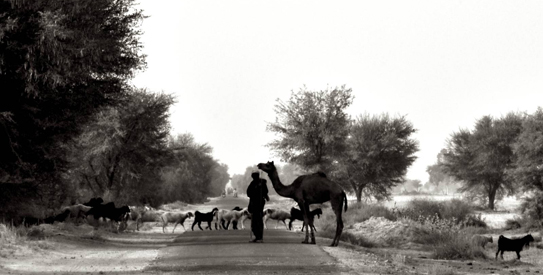The farce of new provinces
By: Mubashar Akram

Feudally oppressed and underdeveloped, the areas are controlled by the very families that are leading the campaign for new provinces. - Photo by Madeeha Syed
Robert. L. Stevenson once said, “Politics is perhaps the only profession for which no preparation is thought necessary.” Too bad Stevenson died long ago or else he would have seen his words coming true in Pakistan. Our politicians, not all but a majority, literally epitomise what Stevenson said. This new debate on creating new provinces in Pakistan proves the point.
“More provinces would weaken the center,” is a rather naïve arguments, especially if one takes into account what happened in 1971. But at the same time, seeing the quality and seriousness of the Pakistani political class eats the arguments favoring the new provinces. Feudally oppressed, deliberately kept underdeveloped and family owned, the areas which are expected to become new provinces are controlled by the very families that are leading the campaign for new provinces.
Take the example of Punjab. The largest province of Pakistan has 36 districts; a population of 81.3 million (56 per cent of the national population) and an area of 205,343 sq km (25.8 per cent land mass). There are voices demanding that Punjab be divided into three parts. There is one movement lead by erstwhile Nawab of Bahawalpur with Senator Muhammad Ali Durrani while the other is harbingered by the Legharis of Dera Ghazi Khan. One similarity that unites the leadership of both these movements: their former status as the rulers of the areas they now want as “their provinces.”
Those demanding a Sereiki province want 19 districts of Southern Punjab and two from Khyber Pakhtunkhwa, respectively, to be joined together into a separate provincial unit. The other group wants the old state of Bahawalpur restored into a province by annulling military dictator General Yahya Khan’s legal framework order of 1970 that merged Bahawalpur into Punjab. The story does not end here because, there first group wants Bahawalpur in their greater Sereiki province and hence, a heated political debate is happening without a winner in sight.
Interestingly enough, those who fear a dominant Punjab and want more provinces out of its womb do not wish the same for gigantic Balochistan that is 43.6 per cent of Pakistan’s geography but only 5.3 per cent of its population. The reaction to Mian Shahbaz Sharif’s very well timed political statement about making Karachi into a separate province (April 24), eats itself because it deflates argument of the political leaders of smaller provinces when they demand division of Punjab into smaller provinces.
Otherwise rarely united, the MQM, PPP and ANP unanimously rejected Shahbaz’s statement and stood for the unity of “one Sindh.” They conveniently underestimated the unanimity in Punjab on the issue of its division and their reactions slapped their stances, vis-à-vis Punjab’s division, in the face. Shahbaz Sharif denied having proposed a separate Karachi province on April 25 but his master stroke exposed the political leadership of the Sindh province. What would be their argument now?
Constitutionally, the path toward creating the new province is, if not totally, but nearly impossible in the present state of politics. Creation of the new provinces involves a constitutional amendment that requires a two thirds majority of both National Assembly and Senate of Pakistan before the bill is sent to the President for his approval. But before this happens, the relevant provincial assembly must adopt a provincial bill, to alter its limits, by two-thirds majority. The Article 239(4) of the Constitution clearly states this fact. A cursory look at the party position in the Punjab Assembly amuses that PML-N has 171 members from the house of 371 members. This makes 46.1 per cent of the total. With this basic fact clear on the political radar, there is an open invitation to fools to keep finding a required two-thirds majority to divide Punjab with Mian Shahbaz Sharif as the Chief Minister.
The story does not end here. The Seriki province seekers want two districts of Khyber Pakhtunkhwa as well. The KP government killed nearly a dozen people in April 2010 on the issue of the name of province that was unacceptable to the Hazara belt in KP. Imagine what the ANP government would do if someone tries to wrest two districts off the KP province.
The Nawab of Bahawalpur wants his old state back with a “pure visionary” like Muhammad Ali Durrani leading the process. Durrani warned President Zardari against including Bahawalpur in the Sereiki province and brandished the “resilience of the people of Bahawalpur.” The PPP, MQM and ANP have already demonised Shahbaz Sharif on the issue of a Karachi province while, the “divide Punjab” brigade does not have the required number in the provincial assembly.
In the end, this is nothing more than a political farce. If nothing else, it would keep the people busy, heatedly debating the issue and probably taking out a few processions here and there. The scorching sun of Southern Punjab and sweetness of mangoes would largely keep the “resilient people” inside their homes. Because a home, even without electricity, is better than the heat, dust, police batons, fumes of tear gas and a night in mosquito-filled lock up. Political leaders are what nations give themselves. Our politicians are wanderers and so is our nation.
The writer is a researcher and is currently working on issues pertaining to violence, extremism and ethnic conflicts in Pakistan.
The Dawn: June 14, 2011